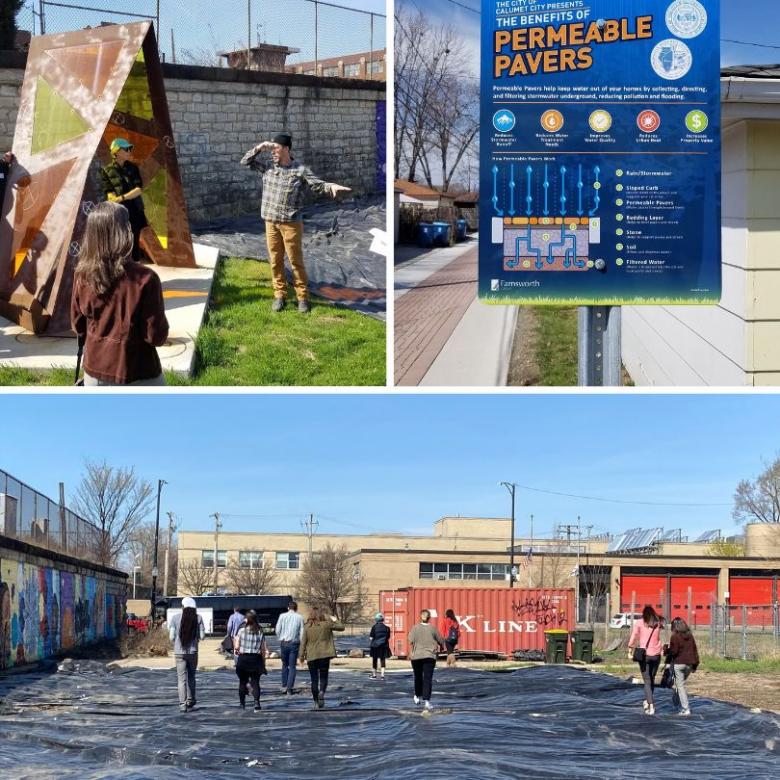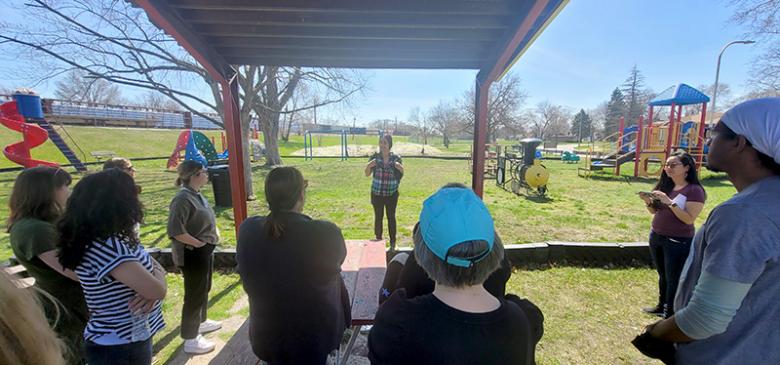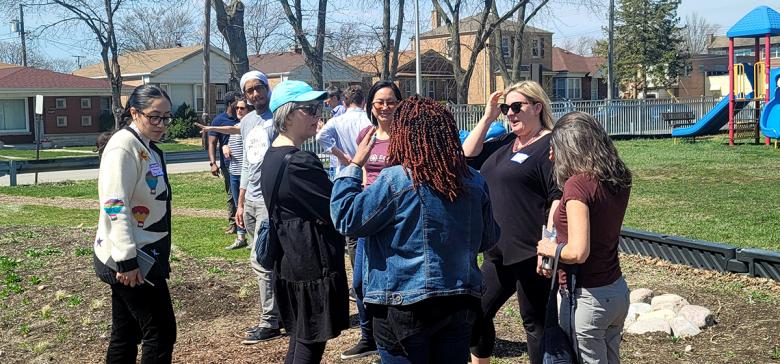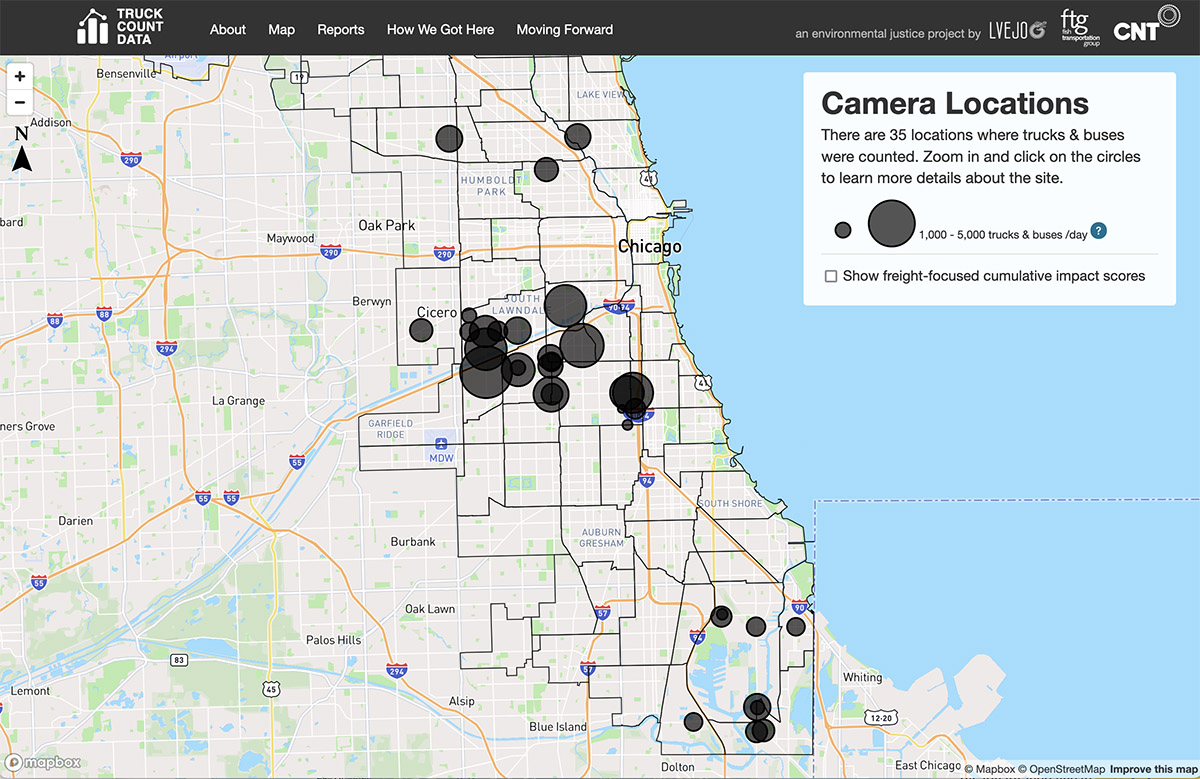
If you had a chance to press pause, reflect, and bask for a moment in the great work you and your team, partners, and funders achieved, what would that carefully curated day look like?
Inspired by a request from Kresge Foundation Environment Program Officer Yeou-Rong Jih, we took an equitable green stormwater infrastructure tour in Chicago – a reunion for many who had not been together since before the pandemic – from an idea to reality on Tuesday, April 11.
Even the weather and traffic cooperated to provide a day that couldn’t have been more perfect to reunite talented colleagues across teams, committed partners, and funders eager to see the impact of their investments for a green stormwater infrastructure tour like no other! We gathered for a full day as we traveled from downtown to the West Side to the south suburbs and back to visit project sites forced to shutter or run lean during the pandemic.

Tour Recap
Our tour began at the CNT/Greenprint Partners shared office space at State and Madison streets, welcoming guests with networking that was both a homecoming and reunion of sorts for many. Following a continental breakfast , we boarded our bus for a day-long tour to see the result of past and present work that will have a positive impact for years to come:
- First stop was Nature Near Transit site, FarmWorks, 407 N. Kedzie Ave. This urban farm is primed with acres of land for the growth and distribution of healthy food in a food desert, with the potential to also cultivate local jobs.
- Second stop was Edward Coles Language Academy, 8441 S. Yates Blvd. There, we saw a sustainably built schoolyard that has both transformed the experience of the young people that attend school there and also contributes to their daily social and physical development as well as enjoyment. The playground, small sports field, outdoor classrooms, and track are open to all.
- Next up, lunch. We enjoyed a guided community tour, lunch, good conversation and office visit with long-time community partner, CNT board member, and CEO of Southeast Environmental Task Force, Olga Bautista.
- The tour culminated with stops at green infrastructure projects in the Southland (suburban cook county), including a visit to Pekny Park in Riverdale to see the recently installed rain garden there. This was followed by a stop in Calumet City to see permeable pavers at work through the city’s green alleys program. Aesthetically and functionally, the improvements are quite noticeable and distinct, welcomed by residents able to benefit right away and sought after by those who admire the infrastructure in passing, hoping their block or alleyway is next.


Our visits throughout the day featured introductions from local groups at each site. Experts and individuals directly affected by the problem discussed flooding as an environmental justice issue in Chicago and equitable green stormwater as one solution.
Other topics we touched on included what it means to elevate local leadership and community-led design, civic engagement through interagency cooperation and the political conditions that can propel or stall progress, project finance, federal funding, and capital braiding as well as GSI maintenance.
A few additional reflections on the day and lessons learned:

CNT Managing Director, Urban Resilience Shavion Scott photographs a city-suburban tour with funders and partners highlighting bioswales, rain gardens, urban farms, permeable pavers and more.
What GSI means to community
Green stormwater infrastructure is such an effective intervention in our climate resilience and flood mitigation efforts; equitable green stormwater infrastructure is an even more powerful approach – ensuring that communities have access to what they uniquely need to solidify a sustainable future.
From urban farms and safe playgrounds to rain gardens and bioswales that have already deterred hundreds of gallons of water from homes to retention areas disrupting ponding and supporting the budding of florals, and green alleys that illuminate the benefits of permeable pavers, we see the positive impact so clearly.
What GSI means to practitioners and funders
For many of us, GSI is a small piece in the big picture of what gets us out of bed in the morning or that keeps us up at night. It’s one aspect of our life’s work. We care about doing this work well and all of the real people and communities this work will affect, which we don’t take lightly.
Why we should do more tours like this
Nine months into my role at CNT, I thoroughly enjoyed the time to connect and completed the day both inspired by the thinkers and doers I have the pleasure to call colleagues and re-energized with fresh ideas to share and implement in even more communities. Let’s keep that momentum going and do more of this.
Thank you, Yeou! Your first trip to Chicago ended up inspiring us all. And thank you to everyone whose presence and contributions to the work made the experience one to remember. The bar has been set. Let’s do this again soon!





 Strengthening Transit Through Community Partnerships
Strengthening Transit Through Community Partnerships